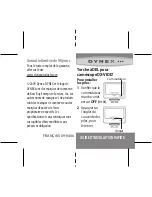
154
VQT3B52
About 3D recording
Attach the 3D Conversion Lens securely.
It must not be used with an insecure
attachment.
Do not use the 3D Conversion Lens
without adjusting it first.
≥
It will not be possible to record 3D video
correctly, and this may lead to tiredness or
discomfort.
≥
When you re-attach the 3D Conversion
Lens after removing it, we recommend
making the adjustments again.
With the 3D Conversion Lens attached,
do not record a subject at less than the
minimum focus distance.
≥
The 3D effects may be more pronounced,
and therefore cause tiredness or
discomfort.
≥
The minimum focus distance is approx.
1.2 m.
When recording with the 3D Conversion
Lens attached, be careful not to shake
the unit.
≥
Tiredness or discomfort may result if the
shake is pronounced, due to riding in a
vehicle or walking etc.
≥
When moving the unit as you record,
move it slowly.
≥
We recommend using a tripod.
About 3D viewing
Anyone who is hyper sensitive to light,
suffers from heart disease or is otherwise
unwell should avoid viewing 3D video.
≥
Doing may have an adverse affect on
such medical conditions.
If you feel tired, uncomfortable or
otherwise strange when viewing 3D
video, stop viewing at once.
≥
Continuing to view may cause illness.
≥
Please rest appropriately after stopping
the viewing.
When viewing 3D video, we recommend
taking a break every 30 to 60 minutes.
≥
Viewing for extended periods may cause
eye-fatigue.
Short-sighted or long-sighted persons,
those with differences in the sight of their
right and left eyes, and those with
astigmatism are advised to correct their
vision by wearing glasses etc.
Stop viewing if you can clearly see a
double image while viewing 3D video.
≥
There are differences in the way that
different people experience 3D video
images. Please correct your sight
appropriately before viewing 3D video.
≥
You can change the 3D setting of your
television or 3D output setting of the unit
to 2D.
When viewing 3D video on a 3D-
compatible television, position yourself a
distance away that is at least 3 times the
effective height of the television.
≥
(Recommended distance):
For 42
z
; approx. 1.6 m,
for 46
z
; approx. 1.7 m,
for 50
z
; approx. 1.9 m,
for 54
z
; approx. 2.0 m.
≥
Viewing from a distance closer than the
recommended distance may lead to eye-
fatigue.
Viewing of 3D video is not recommended
for children under 5 to 6 years.
≥
It is difficult to know how children will react
to tiredness or discomfort, and they may
become ill suddenly.
≥
When children are viewing, have a
responsible adult ensure that eye-fatigue
does not occur.
About 3D










































